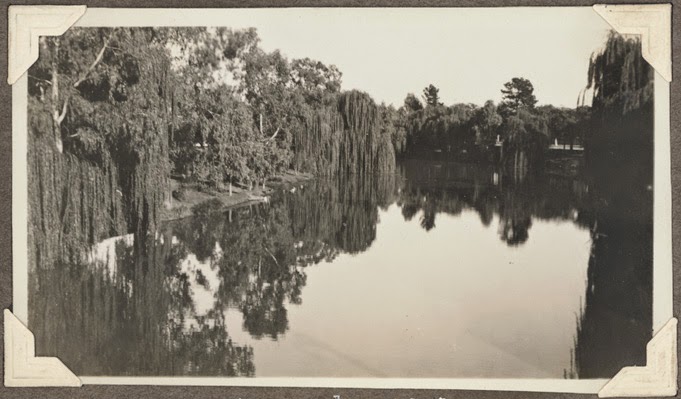Losing our
two rabbits and a beloved cat in a single week (to the heat and a brown snake) in
our first few weeks in Wagga has led me to reflect on my naivety about the
risks our new environment poses and to ponder the strange accidents of history
that have put this fairly Anglo family, with its predilection for William
Morris arts and crafts and Beatrix Potter-style anthropomorphised pets, in
the middle of the Australian bush.
I have been
piecing together what Australian history I already knew and what I am learning
about the Riverina region specifically to help make sense of my feelings –
feelings of loss and displacement side by side with those of exhilaration and
rapidly growing love of this landscape and town.
Such sudden
evidence of the vulnerability of our urban pets has driven home to me with
brutal intensity how paper bark thin is the veneer of suburban decorum here. Kooringal’s winding streets sport bright
green sprinkler-fed lawns, garden beds
of foxgloves and heliotrope and faux classical embellishments adorn the
houses, yet many of those houses, like ours,
back onto rugged, rocky terrain
where heatstroke, snakebite and god knows what other perils await. When the sun
is relentless and the air is humming I can’t avoid visions of Miranda and her
school friends vanishing!
Disappearing into the impenetrable mysteries of the bush, Picnic At Hanging Rock.
I found an unattributed poem* published in the Wagga
Wagga Daily Advertiser of 25th November, 1941 (65 years to the day that I am writing this). It
expresses the solace provided by quiet reflection on the banks of Wollundry
Lagoon, on how the ‘things of Nature, God's
kind forgiving smile’ help to heal both the
soldier’s mind still full of the ‘frenzy
of Tobruk’ and the troubled soul of ‘some forlorn, weak sister’ who has
morally transgressed. Then the poet suddenly conjures up images from the
distant past:
(When) in Wollundry's
garden a vision strange appears
Of native children playing among the
ancient trees,
And camp smoke slowly rising upon the
languid breeze.
No trim lawns then and willows, or
fragrant scent of rose;
Long reeds and waving grasses, and
calling of the crows.
Here dark-skinned men and women;
God's creatures yet untamed
Lived innocently happy, untutored
and unashamed.
They heard the kookaburra with
cheery laughter greet
The sunglow, overspreading the
morning, dewy sweet.
They saw the wild duck leaving their
night-enchanted haunts
And took what Nature offered to
satisfy their wants.
The kangaroos leaped lightly, the
emu loitered near
Sufficient for the hunting, the
boomerang and spear.
The native life was simple. Its
savagery was mild.
And heart, however cultured, still leaneth to
the wild.
There is something very pleasing in unspoilt
forest still.
Ere man with axe and fire has worked
his ruthless will
There heaven-assisted Nature moulds
in unrivalled way
Her monumental splendour from
elemental clay.
Despite its
romantic paternalism (and inaccuracy about who first used fire to manage the land),
the poet is attempting some 100 years after Wagga’s genesis as a European town,
to grapple with the same paradoxes I am.
To reconcile what consoles her of contemporary values and taste with an imagined past she admires as
elemental, innocent and unspoilt. She quickly
excuses herself from judgement with the line “And who shall say the old thing was
better than the new?”
The willows of Wollundry Lagoon in the 1930s (NSW State Records)
But we all
do, constantly, declare an old thing better than a new or a new thing better
than an old. When land was cleared for grazing in the early-mid 19thC the
practice was supported by progressive, benevolent natural scientist and pioneer authority on Aboriginal culture,
Alfred William Howitt, as ridding the land of miasma producing toxins. Also, as
Wagga poet and memoirist, Mary Gilmore relates, sheep and cattle station owners
saw the plants and birds which had flourished in sanctuaries preserved by the local Wiradjuri people for centuries on the Murrumbidgee
as hazards and impositions. They eradicated the river oaks completely and drove
the black swans from their nests smashing their eggs. They believed they were
cleansing the landscape to better provide for their families, they had no inkling
of the salinity that was to affect the soil so soon afterwards. Regeneration of bush and wetlands decades
later shows the old reasserting itself against the new!
Backyard grave for two of our perished pets - memorial mound of local rock.
As classes, cats and rabbits are rightly considered destructive introduced pests in
These questions can’t be answered. All human society is rife with contradiction and compromise. This land is the brown snake’s home and it is also home to Maltese terriers, McDonalds drive thru, alyssum borders, fancy garden statuary from Bunning’s and now also home to our 'rescue' new cats. We hope that, like currency lads and lasses, being Wagga born, they may be prove more robust in this environment.
Whatever comes there will be sadness and there will always be consolation amongst the willows and the now reintroduced river oaks of Wollundry Lagoon.






















